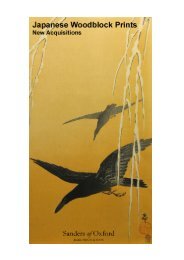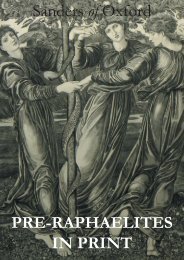You also want an ePaper? Increase the reach of your titles
YUMPU automatically turns print PDFs into web optimized ePapers that Google loves.
GLOSSARY<br />
asobi: ‘Play’: from the verb asobu<br />
bakufu: Military government, dominated in the Edo period (1615-1868) by the Tokugawa<br />
family<br />
bijin: A beautiful woman<br />
bijin-ga: Pictures <strong>of</strong> beautiful women<br />
chatate onna: Literally, ‘tea-brewing women’: waitresses<br />
chônin: Literally, ‘town dweller’: townsmen, <strong>of</strong> the merchant or artisan classes<br />
danna: A patron <strong>of</strong> a geisha<br />
desho: A geisha’s most formal kimono<br />
Edo-jidai: The Edo or Tokugawa period (1615-1868)<br />
enkai: A banquet<br />
eri: A stiff decorative collar<br />
erikae o suru: ‘To turn one’s collar’: the figurative expression marking the change from<br />
maiko to geisha.<br />
furisode: The ‘swinging-sleeve’ kimono worn by unmarried girls and, by extension, maiko<br />
ga: ‘drawn by’<br />
gei: Art<br />
geiko: The Kyôto term for geisha<br />
Genji mon: Codified patterns or devices relating to separate chapters <strong>of</strong> the Genji<br />
monogatari<br />
Genji monogatari: ‘The Tale <strong>of</strong> Genji,’ a novel written in the beginning <strong>of</strong> the eleventh<br />
century by a female writer, Murasaki Shikibu (978-1016)<br />
geta: Wooden sandals<br />
giri: Honour, obligation, duty<br />
hanadai: Literally, ‘flower money’: a geisha’s wages<br />
haori: A jacket worn over kimono<br />
hashi-jôro: Lower-ranking courtesan, originally second-grade<br />
hitsu: ‘From the brush <strong>of</strong>’<br />
hôkan: Comedians who entertained pleasure-quarter women and their clients<br />
iki: Chic or cool; stylishness<br />
Kabuki: Popular theatre which began in the seventeenth century<br />
kamuro: Young female pages<br />
Kanô: Official school <strong>of</strong> painting, in attendance to the Tokugawa shogunate<br />
karyûkai: ‘The flower and willow world’, a term for geisha culture and society<br />
kiseru: A long-stemmed pipe<br />
kitsune: foxes, associated with the agricultural deity, Inari<br />
kôshi-jôro: High-ranking courtesan, just under tayû in grade<br />
koto: Thirteen-stringed ‘harp’<br />
kyôka: Literally ‘crazy verse’. Thirty-one syllable comic or parodic poetry<br />
Miyako: Kyôto, the Imperial Capital.<br />
magaki: Lattice work used in the facades <strong>of</strong> Yoshiwara green houses<br />
maiko: Apprentice Kyôto geisha, now used generically<br />
mizu shôbai: Literally, ‘The Water Trade,’ used to describe the multifarious businesses<br />
involved in the pleasure or entertainment industries that are subject to fluctuations <strong>of</strong> income<br />
or personnel [See Dalby: 2000, p.341]<br />
mon: A crest or insignia, traditionally associated with high-ranking families, they were<br />
adopted by floating world actors and courtesans<br />
monogatari: Story or tale<br />
nishiki-e: ‘Brocade picture’: full colour woodblock print, perfected in the latter half <strong>of</strong> the<br />
eighteenth century<br />
ochaya: A teahouse<br />
ôban: The most common large size <strong>of</strong> woodblock print<br />
obi: Decorative sash worn with a kimono.<br />
okami-san: Proprietress <strong>of</strong> a teahouse<br />
okâsan: ‘Mother’: name used by geisha for teahouse managers












